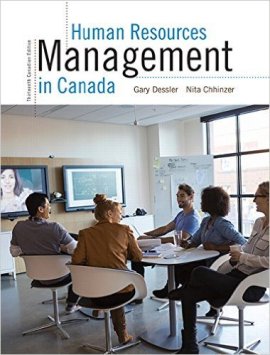Human Resources Management in Canada 13th Canadian Edition By Gary Test Bank
Digital item No Waiting Time Instant DownloadISBN: 0134005449 -13:9780134005447
In Stock
Original price was: $75.00.$35.00Current price is: $35.00.
Human Resources Management in Canada 13th Canadian Edition By Gary Test Bank
Chapter 2 The Changing Legal Emphasis: Compliance and Impact on Canadian Workplaces
1) A company with employees in different provinces/territories must monitor the legislation in each of those jurisdictions because
A) it is specified under employment law.
B) legislation changes and it may vary from one jurisdiction to another.
C) it is required under Canada Labour Code.
D) it is required under the Human Rights Act.
E) legislation has commonalities across jurisdictions.
Answer:
Diff: 2 Type: MC Page Ref: 28
Topic: Hierarchy of Employment Legislation in Canada
Skill: Applied
2) The government in each jurisdiction has created special regulatory bodies to enforce compliance with the law and aid in its interpretation. Two such bodies are the
A) human rights commission and labour unions.
B) ministry of labour and the HRSDC.
C) ministry of labour and labour unions.
D) employment equity commission and ministry of labour.
E) human rights commission and ministry of labour.
Answer: E
Diff: 2 Type: MC Page Ref: 29
Topic: Hierarchy of Employment Legislation in Canada
Skill: Recall
3) Establishing minimum employee entitlements is most closely associated with
A) employment equity legislation.
B) the Charter of Rights and Freedoms.
C) pay equity legislation.
D) human rights legislation.
E) employment standards legislation.
Answer: E
Diff: 1 Type: MC Page Ref: 28
Topic: Hierarchy of Employment Legislation in Canada
Skill: Applied
4) Which of the following statements about equal pay for equal work legislation is true?
A) In the federal jurisdiction, this principle has been incorporated into the Employment Standards Act since 1971.
B) The principle “equal pay for equal work” makes it illegal to discriminate through pay on the basis of age.
C) Entitlements are found in the employment/labour standards legislation in every Canadian jurisdiction.
D) The principle “equal pay for equal work” makes it illegal to pay nurses and fire fighters differently if their jobs are deemed to be of equal worth to the employer.
E) Every jurisdiction in Canada has legislation incorporating the principle of equal pay for equal work.
Answer: E
Diff: 3 Type: MC Page Ref: 45
Topic: Legislation Specific to the Workplace
Skill: Applied
5) Equal pay for equal work specifies that
A) there can be no pay discrimination on the basis of race, gender, or age.
B) male-dominated and female-dominated jobs of equal value must be paid the same.
C) jobs with similar titles must be paid the same.
D) all people doing the same job should receive an identical pay rate.
E) an employer cannot pay male and female employees differently if they are performing substantially the same work.
Answer: E
Diff: 3 Type: MC Page Ref: 45
Topic: Legislation Specific to the Workplace
Skill: Applied
6) If a company classifies male employees as administrators and female employees doing the same work as clerks and provides different wage rates based on the classifications, the company is violating the
A) collective agreement.
B) principle of equal pay for equal work.
C) gender-based discrimination principle.
D) Income Tax Act.
E) none of the above.
Answer: B
Diff: 3 Type: MC Page Ref: 45
Topic: Legislation Specific to the Workplace
Skill: Applied
7) The Charter of Rights and Freedoms
A) is part of the Constitution Act of 1992.
B) applies to all Canadian employees and employers.
C) ensures that no laws infringe on Charter rights.
D) takes precedence over all other laws.
E) is fairly limited in scope.
Answer: D
Diff: 2 Type: MC Page Ref: 30
Topic: Legislation Protecting the General Population
Skill: Recall
8) Which of the following statements describe the Charter of Rights and Freedoms accurately?
A) Legislation cannot be exempted from challenge under the Charter if a legislative body invokes the “notwithstanding” provision.
B) The Courts of Appeal are the ultimate interpreters of the Charter.
C) The Charter allows laws to infringe on Charter rights if they can be demonstrably justified as reasonable limits in a free and democratic society.
D) Employment standards legislation supersedes the Charter.
E) It applies to employees in certain provinces only.
Answer: C
Diff: 3 Type: MC Page Ref: 30
Topic: Legislation Protecting the General Population
Skill: Applied
9) The Charter of Rights and Freedoms and the rights it contains, such as freedom of association, apply to
A) private sector employers only.
B) actions of the federal government only.
C) actions of the federal, provincial, and municipal governments.
D) public and private sector employers.


Reviews
There are no reviews yet.